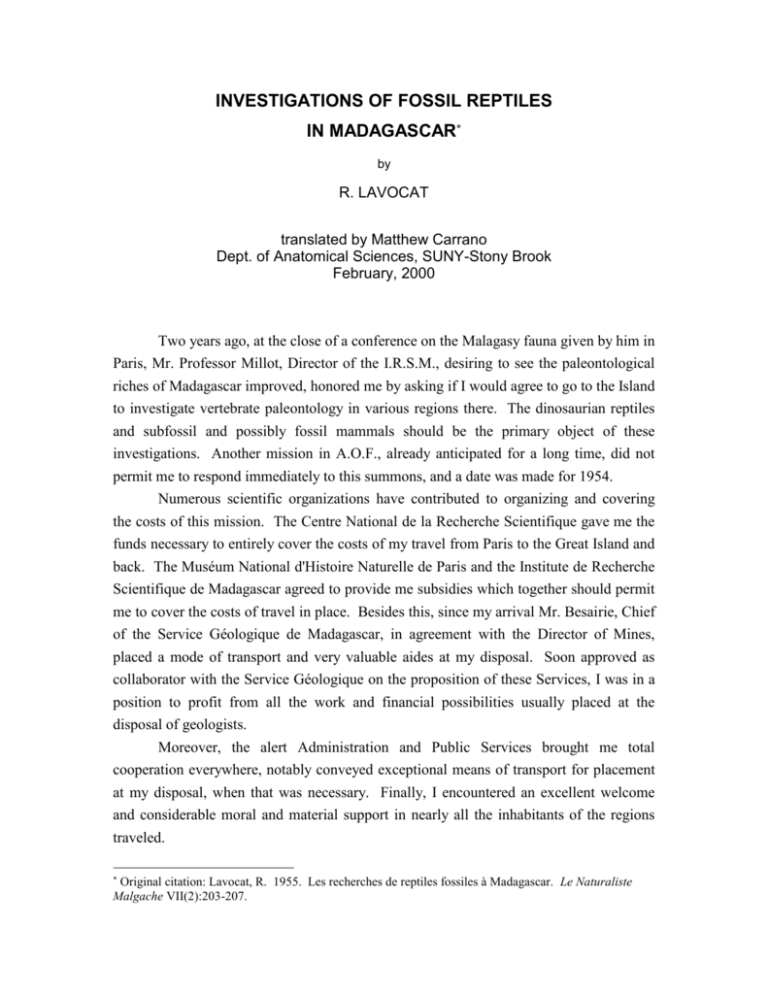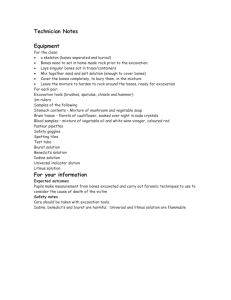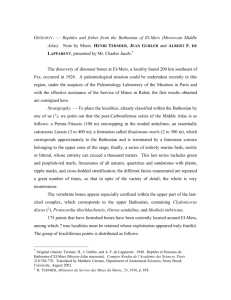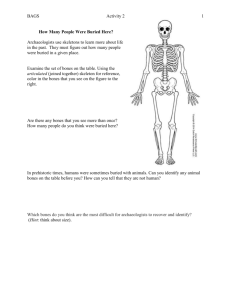Lavocat 1955b
advertisement

INVESTIGATIONS OF FOSSIL REPTILES IN MADAGASCAR* by R. LAVOCAT translated by Matthew Carrano Dept. of Anatomical Sciences, SUNY-Stony Brook February, 2000 Two years ago, at the close of a conference on the Malagasy fauna given by him in Paris, Mr. Professor Millot, Director of the I.R.S.M., desiring to see the paleontological riches of Madagascar improved, honored me by asking if I would agree to go to the Island to investigate vertebrate paleontology in various regions there. The dinosaurian reptiles and subfossil and possibly fossil mammals should be the primary object of these investigations. Another mission in A.O.F., already anticipated for a long time, did not permit me to respond immediately to this summons, and a date was made for 1954. Numerous scientific organizations have contributed to organizing and covering the costs of this mission. The Centre National de la Recherche Scientifique gave me the funds necessary to entirely cover the costs of my travel from Paris to the Great Island and back. The Muséum National d'Histoire Naturelle de Paris and the Institute de Recherche Scientifique de Madagascar agreed to provide me subsidies which together should permit me to cover the costs of travel in place. Besides this, since my arrival Mr. Besairie, Chief of the Service Géologique de Madagascar, in agreement with the Director of Mines, placed a mode of transport and very valuable aides at my disposal. Soon approved as collaborator with the Service Géologique on the proposition of these Services, I was in a position to profit from all the work and financial possibilities usually placed at the disposal of geologists. Moreover, the alert Administration and Public Services brought me total cooperation everywhere, notably conveyed exceptional means of transport for placement at my disposal, when that was necessary. Finally, I encountered an excellent welcome and considerable moral and material support in nearly all the inhabitants of the regions traveled. * Original citation: Lavocat, R. 1955. Les recherches de reptiles fossiles à Madagascar. Le Naturaliste Malgache VII(2):203-207. The following pages strive to indicate how it proceeded so easily by so many concerted efforts, which can be hoped for the future and for the assistance that they can bring all those who are interested to the Great Island. The overall program indicated above was immense and involved an ordering in the time of tasks to accomplish. The first experiences should permit specifying this order. With regard to investigations of dinosaurs, which it was decided would be the first to be undertaken, the spaces to travel were enormous. Study of the geological map and the materials recovered from old discoveries showed that the Jurassic zone to prospect, Isalo III, covers a wide band along the entire west and northwest edge of the Island, and traverses the north end from there up to Vohémar. To be restricted to the apparently most privileged zone, it still is an arc running from the Betsiboka at the west up to Antsohihy at the north, all along the Kamoro, then east of the Mahajamba. The Cretaceous, for its part, presents immense exposures outcropping from Marovoay up to the Mahajamba, at the center of the Jurassic arc. The preceding year, important surveys were marked by General Collignon, who had found, excavated, and called the attention of the Académie Malgache to important fossiliferous spots. These localities, situated near Tsinjorano I, not far from the Kamoro and on the west route, were signaled to him by Mr. Aubaric, a farmer in this village. Naturally, I first centered at my researches on this region, and I must say how considerable was the aid which was accorded to me by Mr. Aubaric. It was an important, immense part in the success of my investigations, and I wish to thank him here particularly, moreover without omitting all the farmers of this region who were willing to help me. The program included a broad overall reconnaissance of the fossiliferous zones by traveling the terrain, associated with multiple contacts with all the farmers and notables of the interested regions, in order to alert them and organize an information service by them with regard to the localities. The Tsinjorano zone having already been put into a state of alert previously and appearing rich, it seemed reasonable to prospect it first and more attentively in order to acquire as precise an idea as possible of the usual conditions of the locality. The weather, comparable to the Sahara where I had worked for a long time, is uncomfortable enough at the start of winter, because of the streams still lacking water and the thick vegetation cover; furthermore, this makes visibility of the outcrop sections very poor, both near and far. In contrast, the considerable density of a population comprising many herdsmen who circulate often and everywhere, brings a significant means of information, provided that they are put in confidence. Definitively, although having made numerous methodical prospecting trips, it must be confirmed that practically all the Jurassic localities have been found based on such information, under the control of a guide having noted a specific spot. Numerous fossiliferous spots were thus recovered. Very frequently it is only a case of isolated bones: several vertebrae, one or two fragmentary long bones. But often enough, important groups of bones are observed on the surface, unfortunately unusable because they were discovered them long ago by erosion and deeply degraded by inclement weather. Fortunately, it is not uncommon to also find fairly clear indications of significant collections still buried. This is naturally the type of locality which presents great interest. In effect, the excavation is generally easy because the rock is essentially made of a poorly consolidated sandstone and easily broken clayey beds, and the very well-preserved bones from Jurassic sites can most often be extracted and wrapped without exceptional precaution: it is enough to wait for them to lose their humidity from the quarry, and they usually become very resistant. The exploration campaign, the first part of the program, covered a wide sector. Nevertheless, in spite of the projects completed, this year it was impossible to go farther from the Mahajamba to prospect the regions of Port-Bergé and Antsohihy, which seemed very promising. But this part of the work was not abandoned, and all those who were already alerted in these regions, or who will now be, can now undertake an information campaign that should allow the specialist to save precious time, which he will devote to the excavations themselves. To multiply these in all the favorable points is indeed the only way to recover the rare and precious pieces on one day or another. After these long prospecting journeys to prepare for the future, an excavation was made not far from Tsinjorano, in a spot where it seemed that this work must be especially fruitful. At the foot of a butte, along the path of an ox-trail, were several important bones: scapula, sacrum, femur, visible on the surface of a hillock. All around, numerous vertebrae and various long bones spread out on a weak surface permitted the hope that a significant portion of a skeleton was located there, still buried in the hillock. A wagon road allowed accessing the reaches of the locality in a Jeep, with the help of several hundred meters of any terrain favorable for the final approach to this layer. Thus was it possible to go to the site with the necessary workers for the excavation. A preliminary work that is imposed is to establish a sketch of the locality and to lay aside in a special stone-yard all the bony fragments (300 in this case), carefully numbered, that were recovered on the surface. Having thus cleared the site, only now could the excavation commence, with a pick maneuvered prudently as long as there did not seem to be bones in the proximity, and with more precise tools when one approached interesting objects. In the central hillock, the bones were superimposed on one other in a manner that only the tools of minute cleaning – knives, brushes, maneuvers generally for the paleontologist himself – could be allowed there for the work. Around this very dense central zone, the "condensation" core of the eddies which had accumulated the bones of a reptile drawn by the torrent in this spot, less rich zones supported the approach of the pick and shovel. Certain more fragile bones needed to be consolidated by bandages repeated in a thin but hot solution of strong paste, and wrapped in small reinforcing bands formed by glued gauze. One and a half months of this work allowed the extraction of a very significant portion of a skeleton, notably a complete forelimb in anatomical articulation in the locality. The head is unfortunately lacking, but it is necessary to remark that the best localities of the world have furnished many fewer skulls than skeletons, this element being very fragile; it would have been an extraordinary chance to discover one as early as the first excavation. Such as it is, this specimen is by far the most complete of those discovered up to now in Madagascar. In the other places that should be excavated, interesting bones were recovered on the surface, to be sent to shelter from bad weather. In the Cretaceous, many teeth of carnivorous dinosaurs and various isolated bones were recovered on the surface; a magnificent pelvis, belonging to a small sauropod, was extracted, and it seems that there was much to hope for there as well. CONCLUSION As remarked above, most of the localities were found based on information. This indicates the important role that all those who are interested in these problems and who reside in these regions can play: henceforth to provoke and centralize the information, to thus make known the localities, each taking great care not to appropriate the specimens. Except in an exceptional case, where the definitive loss of the specimen is absolutely certain if it is not removed, extraction by non-specialists generally involves, for vertebrates, either the destruction or a very great depreciation of the specimen. It is necessary that the specialist realizes himself on the spot of what seems in reality one piece, and in that case can collect the small fragments that, reconnected, would multiply the scientific importance of this piece. Numerous pieces of high importance were found unusable, either because their connections were not certain, or because the person who extracted them did not realize that he had seen only a part, and had broken them all irreparably. The simple placement of a specimen in the locality speaks frequently to the specialist, and it alone can give him some certainties that better information cannot procure secondhand. Except in very rare cases, the work is therefore essentially a task of persevering to encourage the inhabitants, who it is necessary to keep in trust, to visit and locate the localities by construction of signals easily noticed from a distance. This work brings considerable services and those who do it are the very precious collaborators of science. CAPTIONS PL. V (top) Manariabo locality, view of group. A humerus, the manus, a femur are seen. (bottom) Radius, carpus, manus in articulation in the locality. PL. VI. (top) Transport of a fragment (1.3) of the femur in plate V. (bottom) Pubis during removal.









